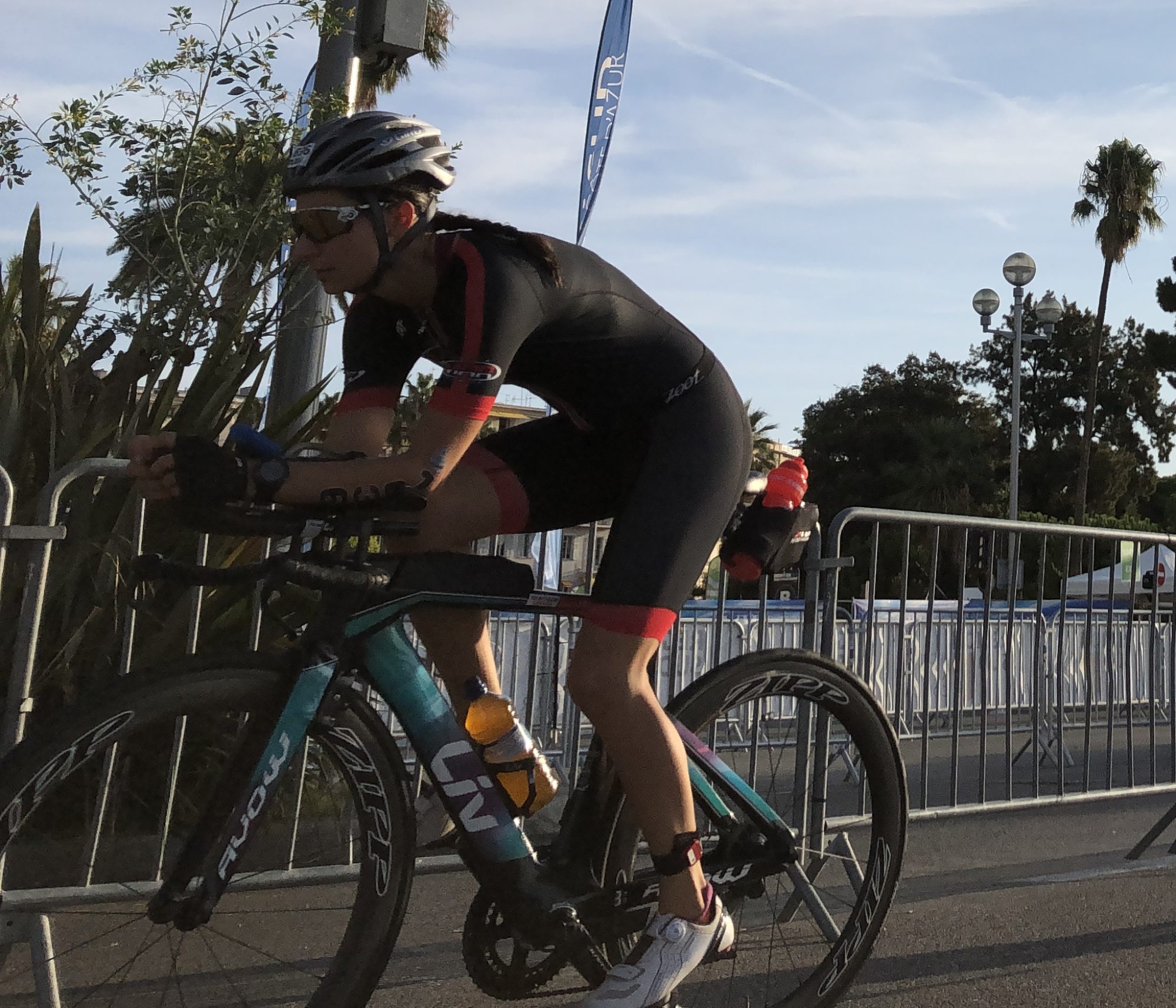Pre-Race
This was the final and seventh year of Ironman Canada being held in the beautiful resort town of Whistler, BC, before it returns to Penticton in 2020. According to the Ironman website, Ironman Canada was the first Ironman race established outside of Hawaii in 1983 and was hosted by Penticton every year until it moved to Whistler in 2013. Rod and I have only been to Whistler – twice – during the winter and it’s a special place for us because it was our first ski trip as a couple. Now that we have officially moved from Ontario to Nanaimo, it is a welcome change to be able to drive there in only a few hours, including a short ferry ride. It’s also a noteworthy event because it’s my first full Ironman race. Last August, I registered Rod and I for the full Ironman after a brief conversation; he was unpleasantly surprised after receiving an email that said, “Congratulations! You are now registered for the Subaru 2019 IRONMAN Canada!”, as he thought that I was signing him up for the half Ironman distance (Ironman Canada offers a 70.3 race on the same day as the full). My best friend and long-distance training partner, Emily, along with her husband, were also competing in their first full Ironman in Lake Placid on the exact same day as our race. Although I was sad that we weren’t doing the race together, we would be swimming, biking and running the exact same distances, only three time zones apart and in different countries.
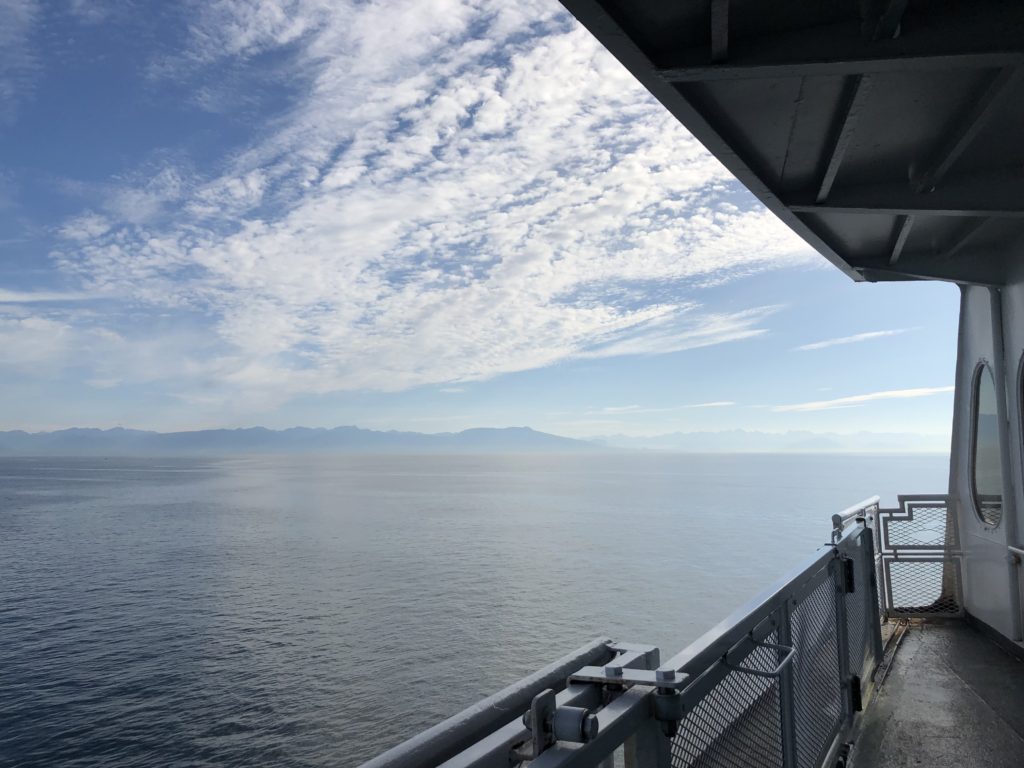

Friday, July 26th
Rod and I woke up just after 5 am to finish packing before catching the ferry. After a high-calorie breakfast, we left shortly before 8 am to ensure we made it on the 8:45 am ferry. (Side note: If you are traveling with a vehicle via BC Ferries in the summer, always make a reservation, even if you’re not traveling on a weekend or holiday. It only costs $10/trip if you make your reservation at least 7 days before you travel and can save you a boatload of time and headache.) It was a gorgeous, warm summer day and a few degrees hotter on mainland compared to Vancouver Island, where there is always a pleasant breeze.
We drove directly to picturesque Rainbow Park for an easy, 20-minute swim in Alta Lake. The water was noticeably colder (probably 20 degrees Celcius) and choppier than Westwood Lake, where we have done 90% of our open water swimming and I appreciated having a wetsuit. After our swim, we drove to Whistler Village and ran into our coach, Melanie McQuaid, on the main street. Rod and I attended the pre-race briefing at 2 pm, then met up with our MelRad Racing team for a group photo in front of the Whistler Olympic rings. Mel encouraged us to walk around with a water bottle glued to our hands and to spend as much time with our legs up, lying around in our Airbnb’s before the race. After we completed athlete check-in in the Village, I stopped by the Brava tent to chat with one of the co-founders, Stephanie, who I met at Victoria 70.3 and was surprised to realize that she remembered me! I purchased a pair of rad Oakley sunglasses and stocked up on more First Endurance Canada EFS Liquid Shots. As I had already “packed the fridge” in Rod’s truck, we only needed to buy ice cream and apple pie before checking into our Airbnb in Creekside. For dinner, we ate leftover salmon and steak (surf ‘n turf!), roasted potatoes, salad and dessert.
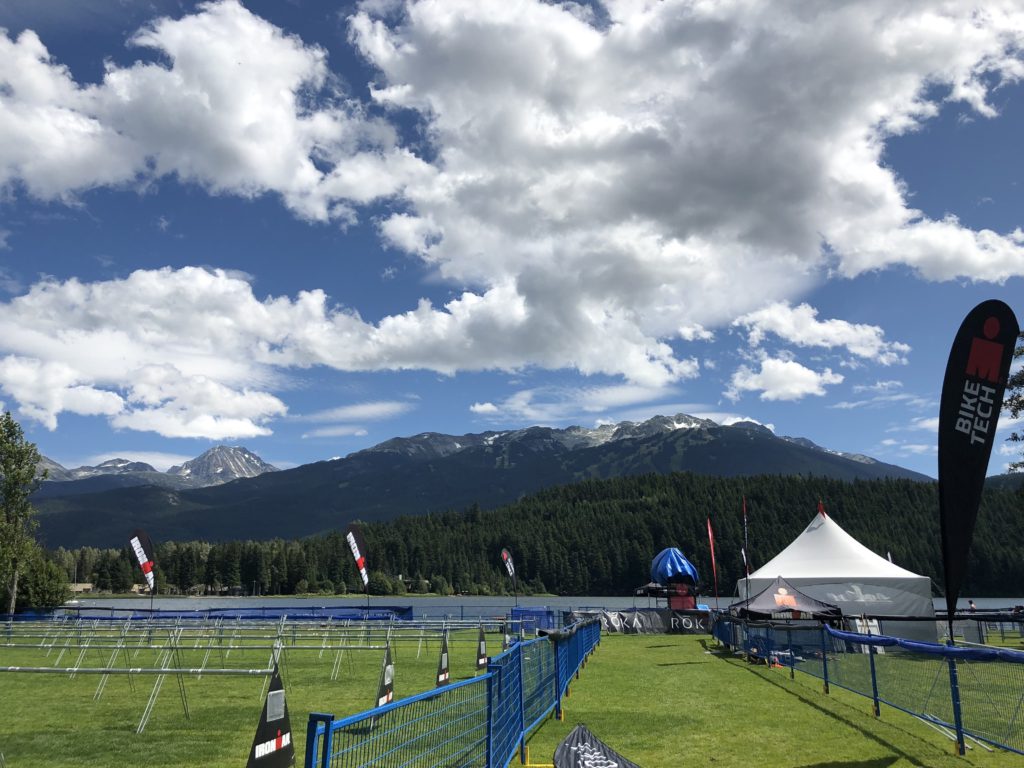
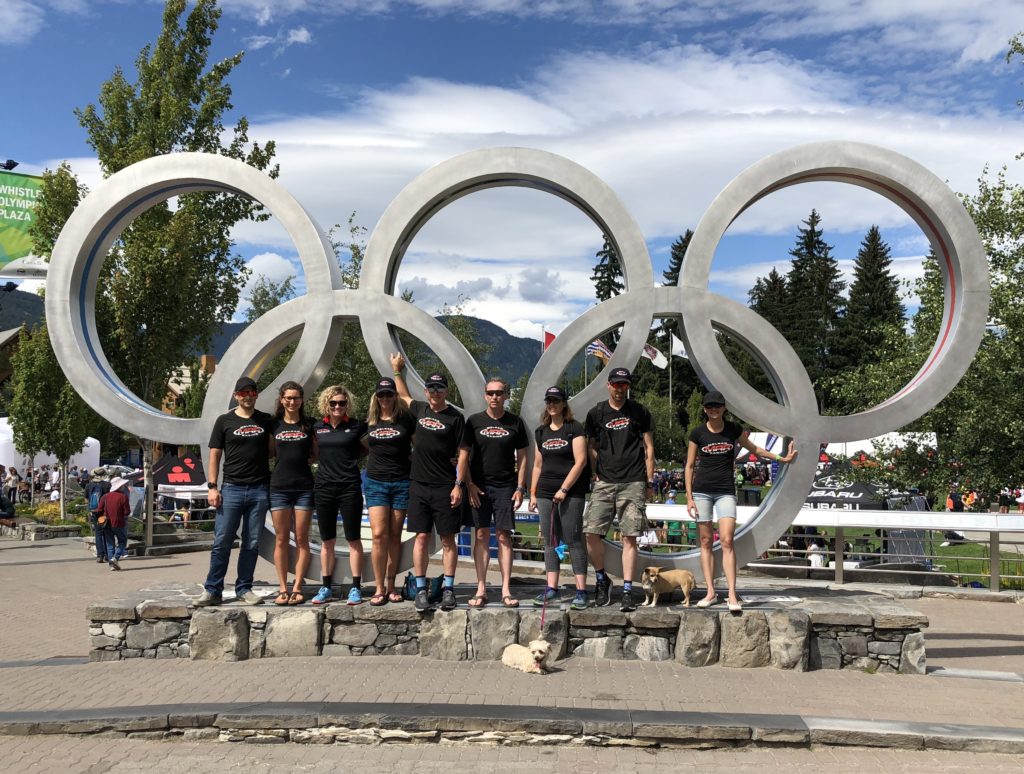
Saturday, July 27th
Rod and I woke up around 7 am and enjoyed a lazy, relaxing morning as it had rained overnight and the roads were too wet to go out and ride first thing. Our coach had advised us to eat simple, easy-to-digest, white carbohydrates and avoid high-fibre foods and vegetables for two days leading up to the race. For those who know me, this was a huge shift from my whole grain, high-veggie diet, but I trusted that Mel knows best. We finally got rolling around noon and did an easy 30-minute ride up Highway 99 to Alpine Road and back, which would be the northern turnaround point of the bike course, followed by a 15-minute run with a few strides from our place in Creekside.
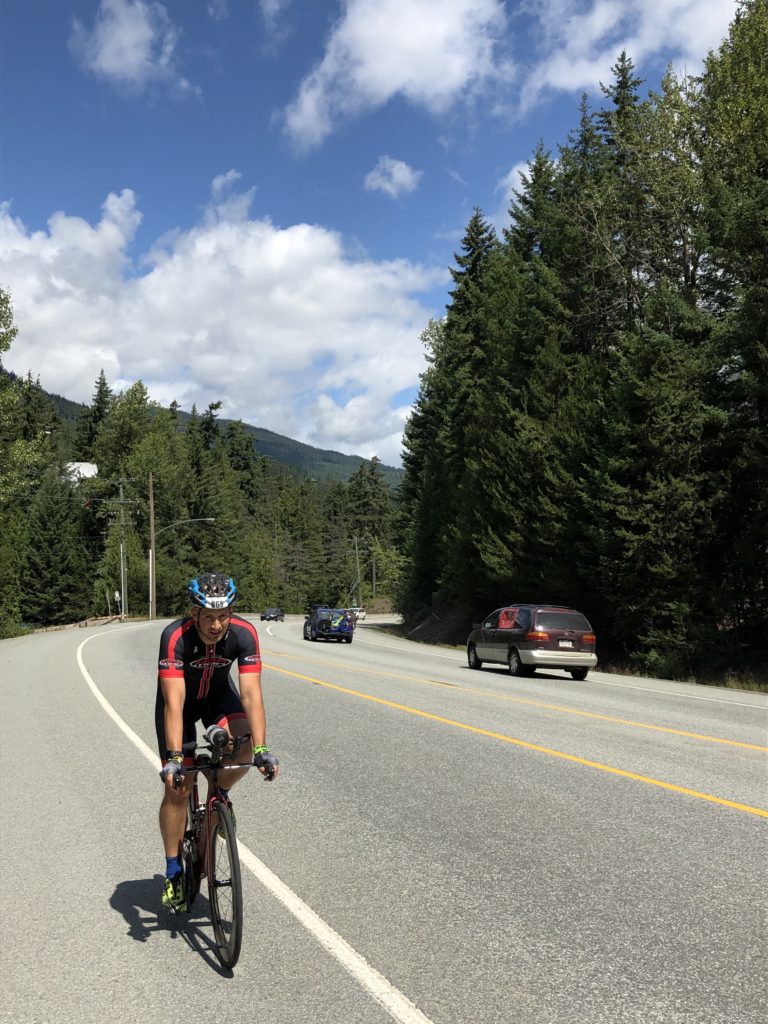

Post bike ride 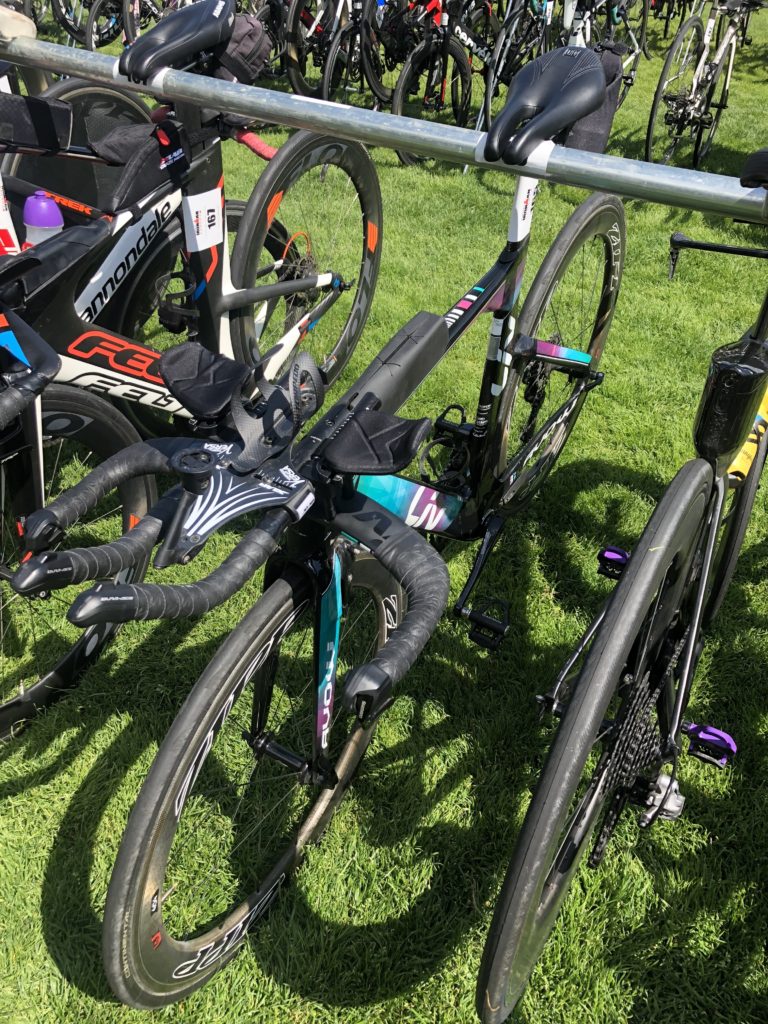
Bike racked & ready to rock 
One of many bears in Whistler
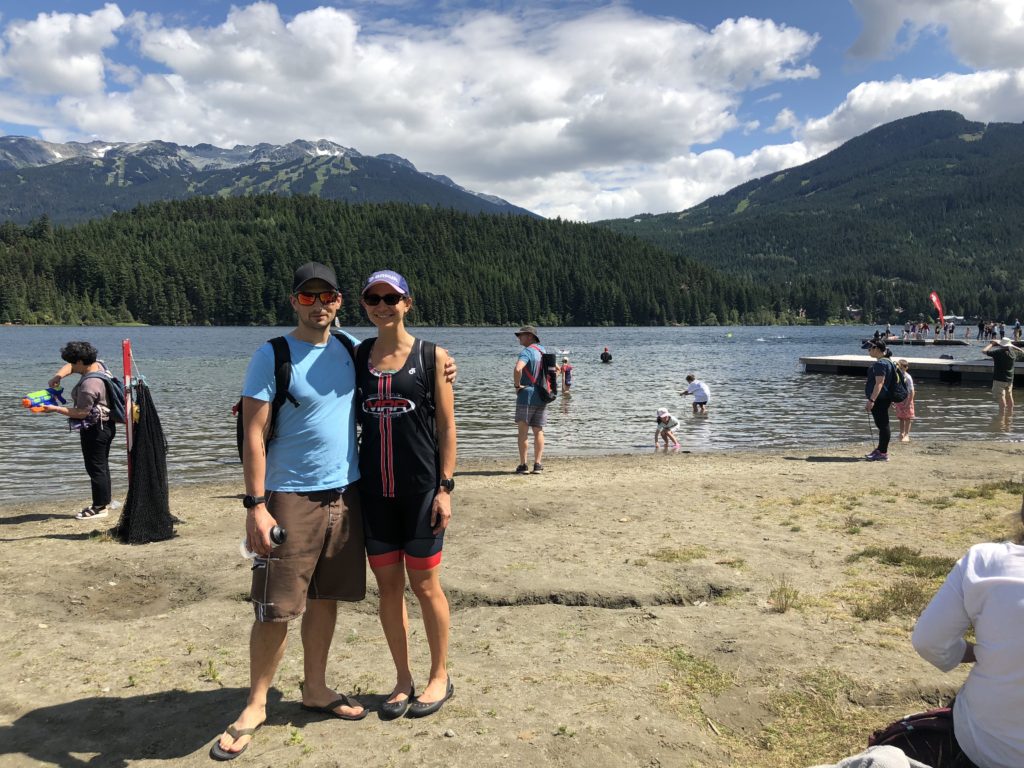
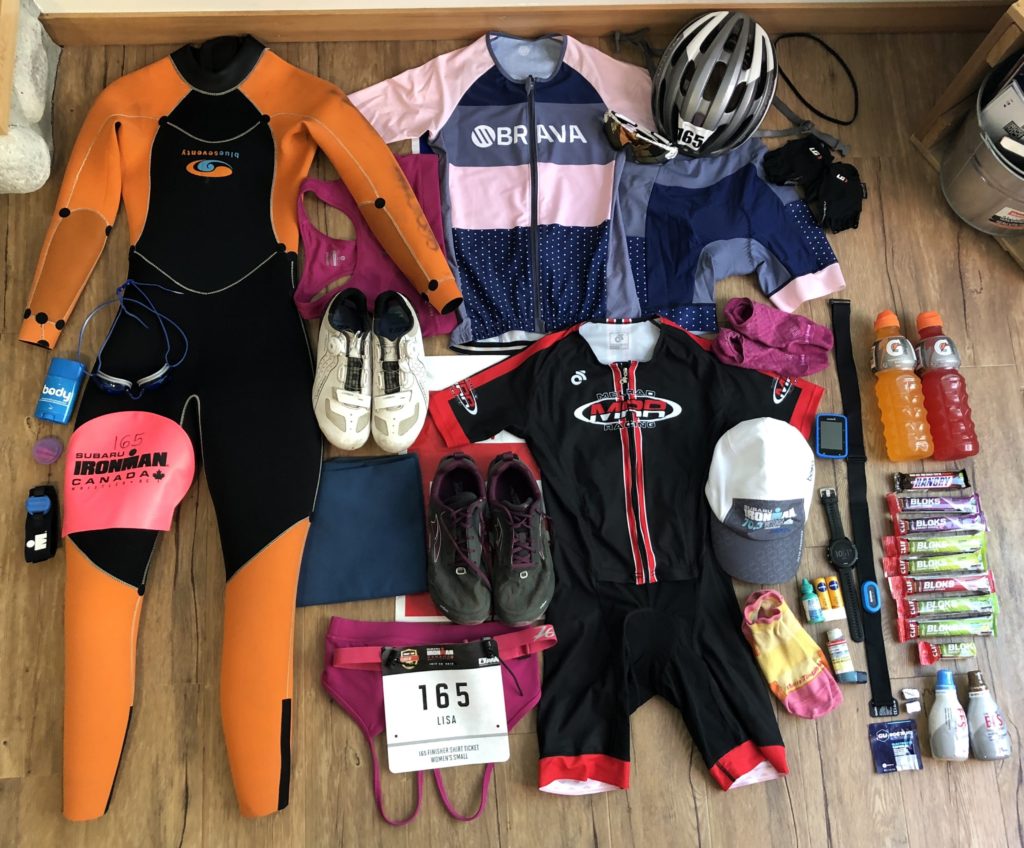
We devoured tuna sandwiches and watermelon for lunch, then headed over to Whistler Village. Ironman Canada had two transition zones – Transition 1 was located in a grassy area of Rainbow Park by Alta Lake and Transition 2 was in a parking lot in Whistler Village. This was the first race I’ve done where we had two different transition zones, which made it crucial to plan out exactly what clothing, shoes and nutrition to put in each gear bag. I took photos of what I had placed in my bike gear and run gear bags on Saturday to ease my anxiety about forgetting something later on that day. Around 2:30 pm, Rod and I leisurely cycled over to Rainbow Park with a huge group of triathletes; I racked my bike in T1, let a bit of air out of my tires and dropped off my bike gear bags. We hopped on the shuttle (school) bus back to Whistler, dropped our run gear bags off in T2 and wandered around the Village. We returned to our Airbnb to relax and organize our race gear. I laid out my nutrition, opened the Gatorade bottles (froze 2 of them for Bike Special Needs bag), cut up my Snickers bar into 5 small equal pieces and put it in the fridge. As per Mel, we ate dinner at 5 pm: white pasta with homemade turkey meatballs and a small portion of dessert. I FaceTimed with Emily to wish her good luck and shared some nervous laughs before she went to bed three time zones away. To ease our nerves, I convinced Rod to watch the Bachelorette: The Men Tell All episode; I read for a bit and dry needled my lower legs before going to bed at 9:30 pm.
Sunday, July 28th
Race Morning

I fell asleep surprisingly quickly and woke up at 2:50 am, 10 minutes before my alarm went off. I had butterflies in my stomach and I thought immediately of Emily and my MelRad teammate, Jason P., who would be starting their 3.8k swim in Mirror Lake in Lake Placid any minute. Rod and I each ate 3 pieces of French toast, topped with maple syrup, sunflower seed butter for me, strawberries and bananas for breakfast. At 4:10 am, we left the Airbnb and managed to snag a perfect parking spot in Whistler Village, where it was thankfully too early to pay for parking. We dropped off our Bike and Run Special Needs bags, added nutrition to the run gear bag (we weren’t allowed to put any food in it the night before due to the risk of attracting bears), made a porta potty stop and hopped on the shuttle bus to Rainbow Park just after 4:30 am. The bus took the long way around, as Alpine Road was probably already closed for the race. We arrived at Rainbow Park around 5 am; Rod and I took advantage of using the park washrooms with luxurious flush toilets before the short walk down to T1. The sun was just starting to rise and it was only 10 degrees Celcius but at least there was no wind. There was a stunning mist on the calm lake surface with dramatic snow-capped mountains in every direction. I felt very fortunate to live so close to such an incredible place and to call British Columbia my new home.
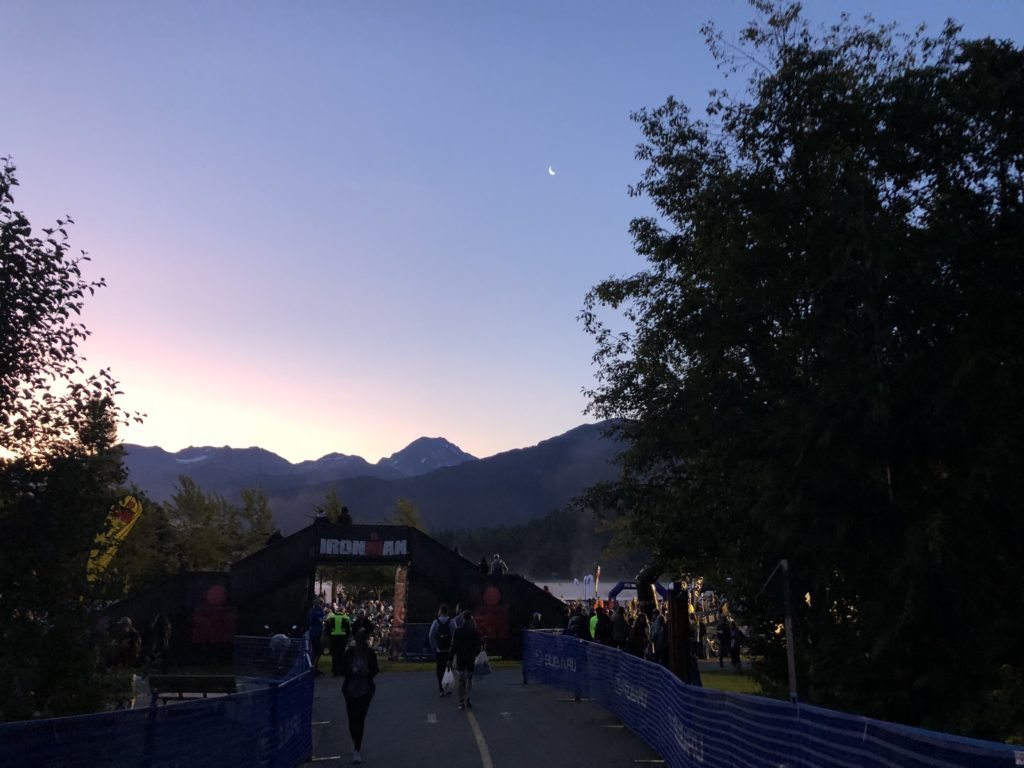
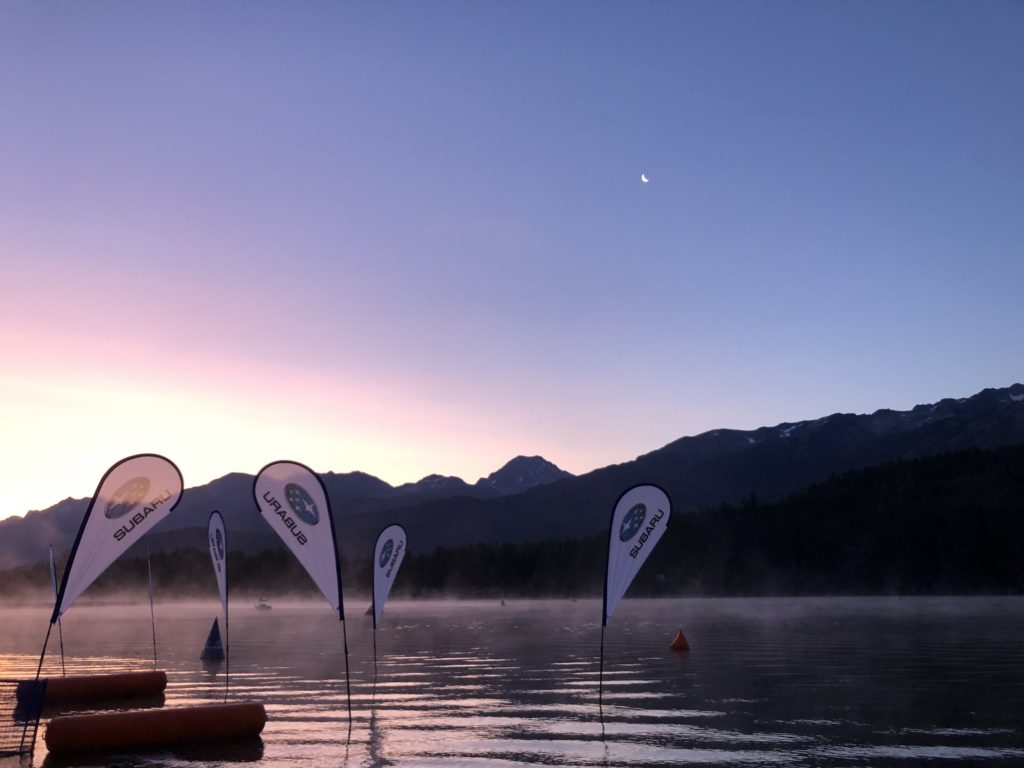
Rod and I usually lose each other before the start of every triathlon, but we set a meeting spot before we went off to set up our bike nutrition. I pumped up my tires to 100 psi, toweled off my bike seat, handlebars and frame and set up my nutrition – water in torpedo bottle, 2 Gatorade bottles with extra Gu Roctane electrolytes, Clif Bloks x 6½ sleeves (39 bloks total) and portioned Snickers bar. I met Rod at the bike gear bag area around 5:30 am, put on my wetsuit, ate 3 Clif bloks and realized that I didn’t have time for a run or swim warm-up as suggested by my coach. We dropped off our Morning Clothes bag and walked over to the “60-70 Minutes” time sign at the swim start area. I gave one of our MelRad teammates, Sonja, a hug and wished her a good race as she made her way through the crowd towards the “50-60 Minutes” swim group. (Side note: It seems like most Ironman races these days are shifting to a rolling swim start, which means that athlete seed themselves based on their predicted swim time and 4-5 athletes are sent off every 5 seconds. In my experience, this makes for a much safer and less congested swim start compared to a mass start.) Ironman staff closed the transition zone, which unfortunately meant I lost the opportunity to empty my bladder one last time in a porta potty.
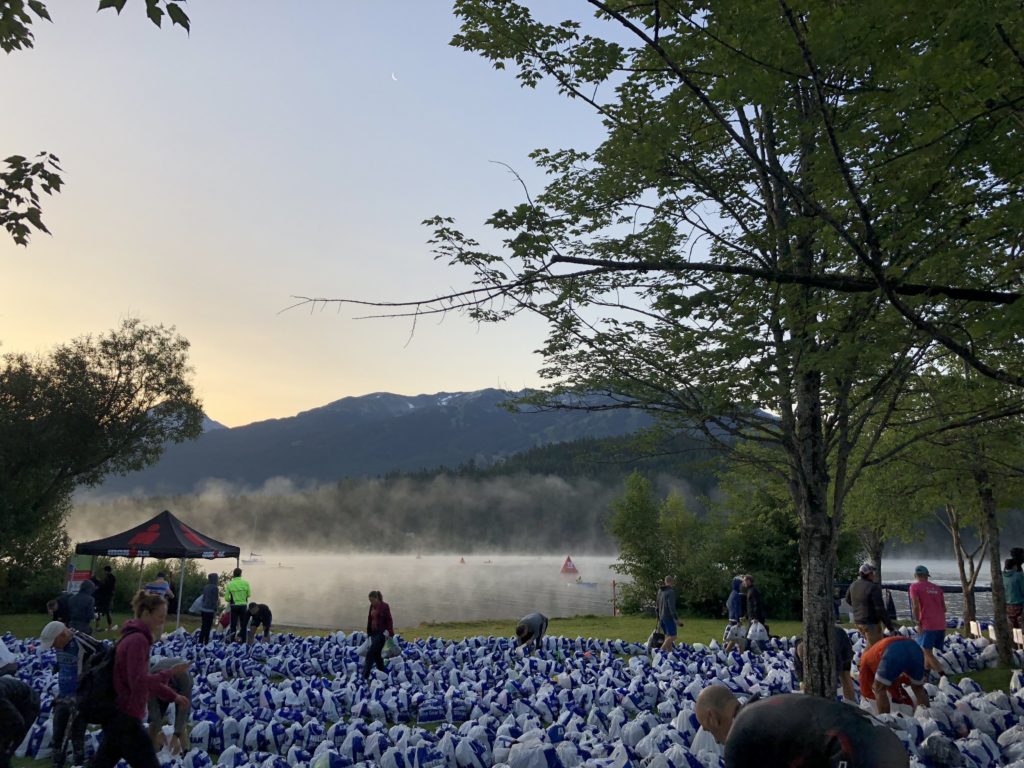
3.8 km Swim
Time: 1:04:48
Pace: 1:40/100m
Division Rank: 7/38
Gender Rank: 30/272
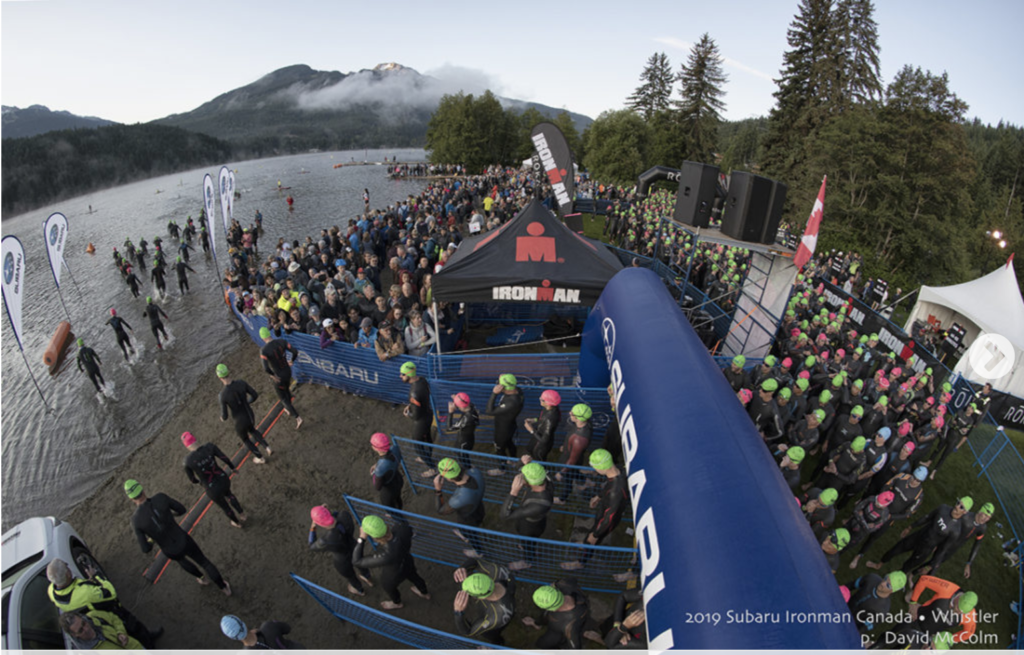
At 5:50 am, the gun went off and the female pros started their race. Shortly after, someone sang O Canada and the self-seeded sub 50minute age groupers started around 6 am, loud pump-up music playing over the speakers. Rod and I remained side by side, our feet freezing on the cold, dewy grass, until it was our turn to wait for the dreaded beep that indicated the official start of what would be a very long day. I sprinted into the water from the beach and dove in when it was just above my knees and started swimming. I tried to swim at what felt like 90% effort for the first 100m or so, keeping my turnover as high as I could. I eased into a comfortable but steady, deliberate pace with high turnover (for me), somewhere between 68 and 76 rpm. I was surprised at how relaxed I felt in the water and I attributed this to doing at least one open water swim per week since late May. It was relatively easy to sight for the first lap; I tried to stay on other swimmers’ feet or hips until I felt 100% confident that I could pass them. I was pleased to notice that I was passing more people than I was getting passed, which surprised me as I hoped that I would swim close to 1h10m.
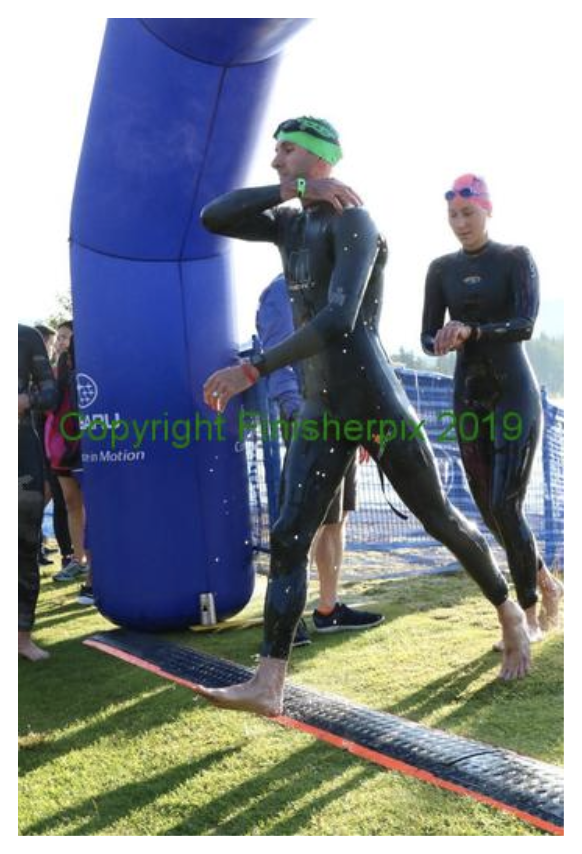
After rounding the last turn buoy that marked the end of the first lap (thankfully we didn’t have to exit and re-enter the water between laps), I checked in with myself and realized that I felt strong and could push the pace during the second lap. I definitely swam more off-course during the second loop. The course became more congested and choppier with added swimmers who had just started their first lap. As soon as I noticed that I had swam off-course, I accelerated to “make up” for lost time then settled back into a good rhythm once I was back on course. The sun started to rise over the mountains and blinded my right field of vision during the long straightaway on the second lap. It was difficult to sight the exit point out of the water; I was unsure when we had to change course and whether to swim off towards shore at the 3rd or 4th buoy. I tried to swim on some guy’s feet for the last 500 to 600m, rounded the last turn buoy, passed him and tried to accelerate for the last few hundred metres.
Out of the water, I glanced down at my watch and was shocked to see I was just under 1h5m. In my daze, I stupidly forgot to unzip the top half of my wetsuit and stumbled over the timing mat towards the wetsuit strippers. Thankfully, the volunteers helped me remove my wetsuit quickly and I lay down on the ground so they could pull it off my legs. I grabbed my Bike Gear bag and ran into the women’s change tent, where a very helpful volunteer emptied my bike gear bag for me. I towel dried my feet, put on socks, bike shoes, helmet, cycling gloves and my new sunglasses; the volunteer helped me put my Brava jersey on. I opted not to put sunscreen on because I was soaking wet – sorry Mom! I ran out of the change tent and almost wiped out into the porta potty, where I made a quick stop before grabbing my bike off the rack and exiting T1.
T1 Time: 4:32
180 km Bike
Time: 5:49:22
Avg Speed: 30.9 km/h
Division Rank: 4/38
Gender Rank: 23/272
This year’s revamped bike course consisted of two challenging, scenic loops. The route went from Alta Lake to the top of Whistler Olympic Park in the Callaghan Valley, then south down Highway 99, with gorgeous views of Black Tusk and nearby mountain ranges, before returning to Whistler to mark the beginning of the second loop. The southbound lane on the Highway 99 was closed to traffic and northbound vehicles were restricted to driving 60 km/h on one northbound lane only, which meant that athletes were given an entire traffic lane in both directions.
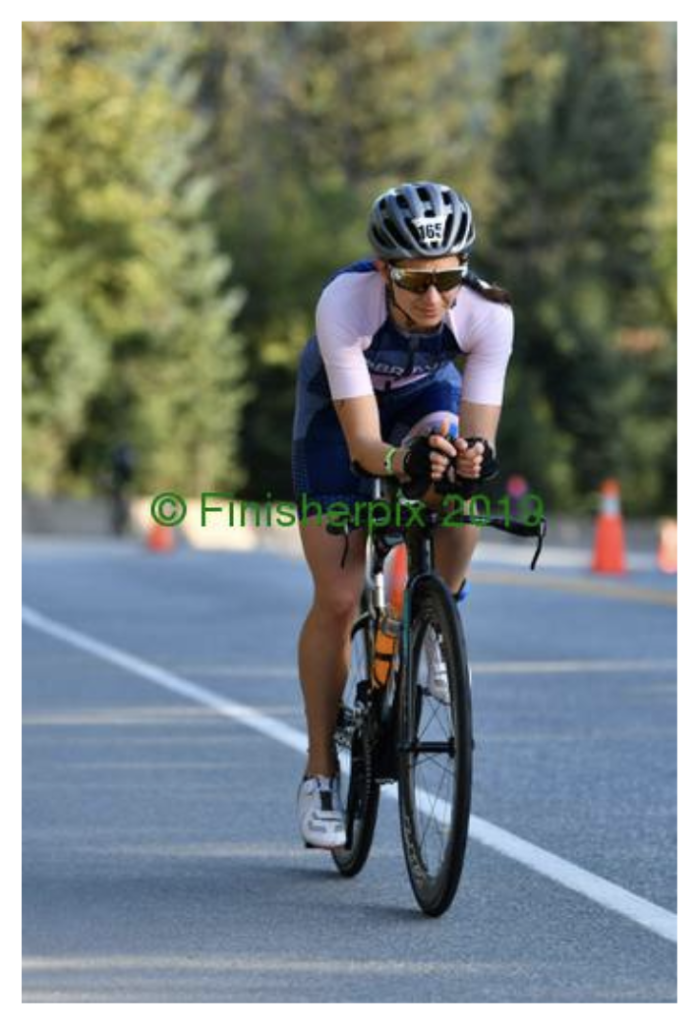
During the ride, I focused on three main things: 1) maintaining a steady, deliberate effort; 2) sticking to my nutrition plan, which meant eating and drinking more than I felt like I needed at the time, and 3) trying to remain as aerodynamic as possible by tucking my chin, looking down between my aerobars and periodically glancing back up at the road to ensure I wasn’t going to hit anything. Psychologically, I broke the bike down into 2 x 90 km rides to make the distance less daunting.
According to my Garmin bike computer, it was a chilly 6 to 8 degrees Celcius for the first part of the ride. It was still pretty early in the morning and most of the route early on was in the shade, but compared to Lake Placid 70.3 in 2018, you could tell it was going to warm up and it was too warm for me to wear sleeves or a vest. I rode cautiously from Rainbow Park out to Highway 99 while focusing on getting my heart rate down from 155 bpm and ingesting plenty of fluids and food from the start. After turning right onto Highway 99, I settled into a good rhythm and focused on maintaining a deliberate pace, but not pushing too hard and not spinning too quickly. I didn’t have my cadence reading in front of me, but I felt like I was pedalling around 80 rpm. I had so much energy riding past Lorimer Road and Whistler Village – I felt like I was given bonus cheering (especially from fellow women) as I guessed that I was probably one of the first 50 women out on the course.
After 22 km (~37 min), I arrived at the bottom of Callahan Valley and began the dreaded 12.4 km climb; I vaguely remembered driving up to Whistler Olympic Park with Rod back in March, but there were high snowbanks on both sides of the road and I was more amazed at the beautiful vistas, rather than trying to memorize the undulations of the road. My legs were excited to rise to the challenge of ascending Callaghan Valley and I definitely prefer hilly bike courses over flat and fast courses. I maintained what felt like a moderately hard intensity the entire way up and kept my heart rate below 155 bpm. I was pleasantly surprised to realize that the road was rolling, not an unrelenting, steep uphill climb the entire way; it felt easier than doing hill repeats up Observatory Hill in Saanich. As I was climbing, I noticed that athletes who were descending had to use their brakes for short sections, and I reminded myself to get out of my aerobars as I was descending if I wasn’t sure about a particular turn in the road.
After the turnaround at the Biathlon Range, I popped my second small piece of Snickers in my mouth and chased it down with water as I began the exhilarating descent down Callaghan Valley. I was definitely cautious the first time descending, but I figured it was better to sacrifice a few seconds than to end my race with a devastating crash from being too brazen. There was an unexpected, dangerous dip in the road just before the bridge on the bottom half where I rode over and my whole bike kind of jolted but I luckily didn’t lose anything. There were several water bottles on the right side of the road and on the shoulder as if numerous athletes had also hit the treacherous dip. (Side note: I later found out that one of my teammates lost a water bottle at this exact same spot.)
The next section back on Highway 99 was quite fun, as it continued to descend south until reaching 58k at the turnaround at 1h49m. Within 2 to 3 km after the turnaround, Rod rode past me heading southbound and I used this as motivation to try to maintain my lead on him. It was steady but manageable climbing heading northbound back to Whistler; the first lap of the course was relatively lonely compared to the second lap because the 70.3 race hadn’t started until at least 7 am. One of my MelRad Racing teammates, Alison, was our team’s self-proclaimed, non-racing cheerleader. She cheered for me as I rode past her near the Village; it was awesome to see her and I felt a surge of energy after she cheered my name. At 88k, I stopped at the Bike Special Needs station to swap Gatorade bottles for my half-defrosted ones and for a quick porta potty break. Rod had caught up to me and we rode together (with a minimum of 6 bike lengths apart) for another 20 to 25k up Callaghan Valley, where I overtook him about 75% of the way to the top and remained ahead of him for the rest of the ride. At the aid station right before the top of Callaghan, I grabbed a water bottle and squeezed as much of it into my front torpedo bottle as I could – this was the one and only aid station I used during the ride. I reached the top of the Callaghan Valley section at 3h59m and grabbed another piece of Snickers to digest while I descended more aggressively than my first lap. I think I only got out of my aerobars a couple of times while descending and I was grateful for the bright orange tape marking the dangerous dip in the road and the volunteer that was directing us to ride close to the median.
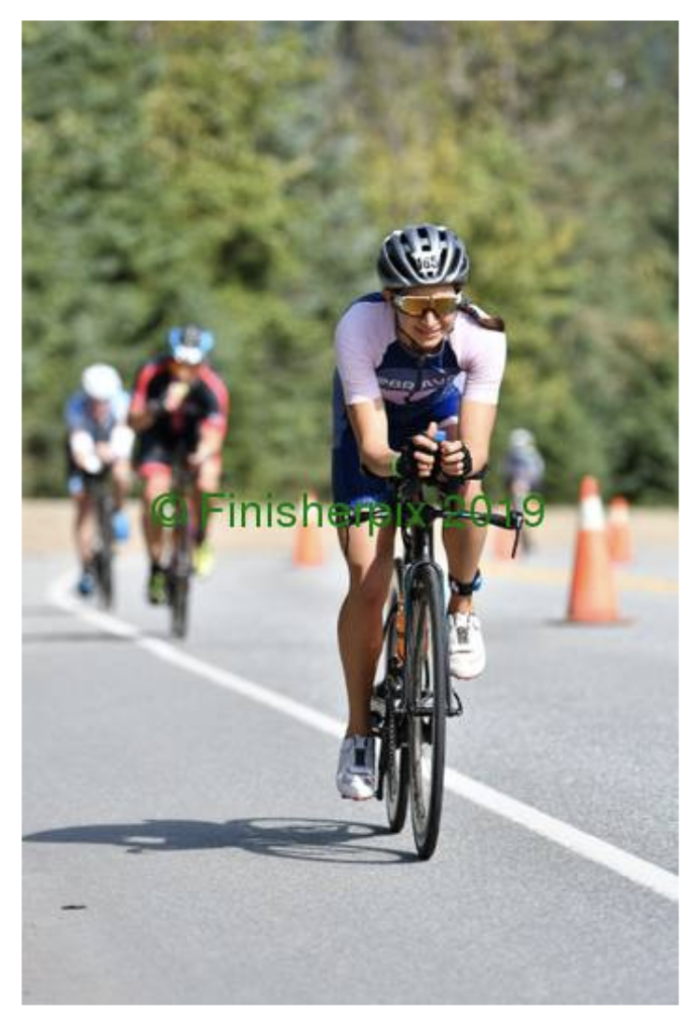
Back on Highway 99, I found myself getting irritated by: 1) my new Garmin Vector 3 power meter pedals (borrowed from Rod) not reading my power output accurately and 2) other athletes around me not abiding by the legal draft zone. I reminded myself that I was probably hungry and/or dehydrated so I continued to eat Clif Bloks and alternate water and Gatorade. By that time, the air temperature had risen into the low to mid 20s and I could feel the sun beating down on me. Thankfully, there were several 70.3 athletes still out on the bike course and I gained confidence with each one that I passed; I was happy to see them because it gave me something to focus on other than the painful chafing that was occurring on the lower half of my body. I was also grateful for the tailwind that assisted me back up to Whistler. I finished the last section of the ride on a strong note heading back into Whistler and made sure to conserve a bit of energy for the pending marathon I wasn’t thinking about but still had to run. Spectators welcomed us back into Creekside, then Whistler Village and it was a somewhat brief out-and-back to the same turnaround point at Alpine Road. I rode through the Special Needs area at the Meadow Park Sports Centre parking lot, headed back down Highway 99, made a sharp right turn towards the Whistler Golf Club, rode under the bridge and then zig-zagged multiple times before reaching the dismount line, where volunteers were waiting to grab our bikes. I had no idea how I would feel running off the bike, but I was definitely happy to be upright and off my saddle.
I ran in my bike shoes over to the Run Gear bag area, found my bag and dashed into the women’s change tent. I did a full outfit change into my MelRad Racing onesie, clipped on my race belt, threw on my hat, grabbed my EFS Liquid Shot nutrition, chugged a cup of water, made another porta potty stop and sacrificed 30 seconds to let three volunteers apply sunscreen to my exposed skin before running out of T2.
T2 Time = 7:15
Bike Nutrition:
- 250 kcal Snickers bar (cut in 5 small bites – 1 bite per hour from 0:00 to 5:00)
- Clif bloks x 2 every 20 min with sips of water
- 4 x Gatorade bottles (591mL each) with added GU Roctane electrolytes
42.2 km Run
Time: 4:02:51
Pace: 9:16/mile or 5:48/km
Division Rank: 3/38
Gender Rank: 30/272
The full marathon distance run course was two laps entirely on the Valley Trail system, which was mostly pavement with a small out-and-back dirt/gravel section adjacent to Lost Lake, where Rod and I cross-country skied in the winter.
My plan was to strive for a 4-hour marathon, which meant that I would have to run 5:40/km for 42.2km. Similar to the bike, I decided to break the run into 4 x 10.5 km segments to make it more manageable in my head, since I had never run a full marathon before and I was about to attempt it after cycling 180km. In my mind, all I had to do was run 10.5 km in 60 minutes or less, and do that 4 times in a row. My plan was to walk all the aid stations during the first half of the race to unload my legs and ensure I was taking in adequate fluids; it would be a game time decision whether to walk the aid stations in the latter half of the run.
Coming off the bike, I was shocked at how fresh my legs felt – which was probably pure adrenaline – and I slowed myself down after realizing I was running 4:50/km out of the gate. The first full aid station was at the start of the Lost Lake trail, and I forced myself to walk the entire station from start to finish; I grabbed ice to dump in my trisuit and water to sip on/splash on my face – I continued this routine at every aid station thereafter. My legs felt pretty good leaving Whistler Village around 6k, especially after another refreshing walk break during the Red Bull/aid station, and hoped that my energy levels would remain high and my legs fresh for the rest of the run.
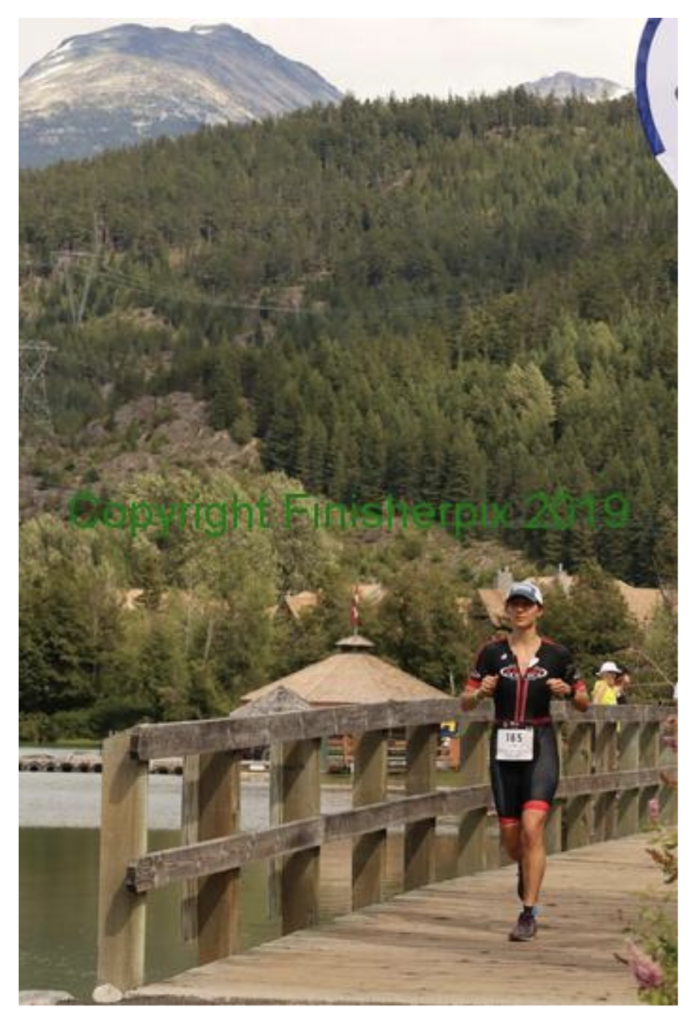
The temperature fluctuated between 25 and 30 degrees Celcius with minimal humidity; I needed to do whatever I could to keep my body temperature cool, so I held ice cubes in my hands until they melted, occasionally brushing one across my lips to keep them hydrated and cool. Around 8.5 km, all I wanted to do was jump into Green Lake and lounge on the giant unicorn floaty that was positioned within jumping distance from the bridge I was running over, with a cold, non-Gatorade beverage in my hand and transform into an Ironman spectator. Having only glanced at the run course map the night before the race, I had a vague idea of how far we had to run out along Green Lake, but I didn’t expect it to feel quite as far as it did. There was a slight but noticeable incline heading back after the northernmost turnaround and I began to pass mostly 70.3 athletes who were walking up the small hill along Green Lake.
By 20k, I had made my way back to Whistler Village and Alison cheered me on, telling me that I looked strong, even though my energy levels were not as high anymore. I reached 21.1k at 1h59m and realized that I needed to maintain the exact same pace (or faster) for the back half of the race in order to achieve my sub 4h marathon goal. Despite the fact that Mel had told me I could run the aid stations in the second half, I liked the brief walking break every 3 to 4 km, so I decided to continue to walk the aid stations for the rest of the race, unless I felt super strong in the last 5 km. After the Lost Lake turnaround, I ran into Sonja and we cheered each other on. Around 24k, I finished my first EFS Liquid Shot flask and grabbed my spare socks, Ventolin puffer and a full EFS Liquid Shot from my Run Special Needs bag. The volunteers were so efficient that I didn’t even have to stop running! My feet were definitely sweaty and rubbing in my shoes, but not so sore that I considered stopping to change my socks. I shoved the socks, along with my puffer and flask, in my rear pocket and kept trucking along.
When I ran through Whistler Village at 25 to 26k before heading out to Green Lake on the second lap, Alison caught up to me, ran alongside me for a moment and said, “It’s going to get really hard, then it will get easy again. Your body can do this, it’s all about your mind.” Those words were precisely what I needed. I was told that the Ironman truly begins at the last 10k, so my mantra became, “When the going gets tough, the tough get going.” I was not by any means the most fit athlete out there on the course, but I felt that I had done a large amount of psychologically hard training that prepared me for this day.
I was surprised that I didn’t feel the need to pee at any point during the run, as I felt like I was drinking a good amount of water. Around 30k, I felt my paraspinal muscles in my lower back threatening to spasm and I focused on achieving a neutral spine and engaging my core – this magically seemed to help (the benefits of being a physio?) and the threat quickly disappeared. Beyond 32k, I found it increasingly difficult to pick up my legs and drive my knee ahead of me and I yearned for the Village crowds to welcome me to the finish line. I also started to feel mildly nauseous and had trouble focusing on spectators’ faces, almost as if I was dizzy. I forced myself to smile and focused on counting down the kilometres that were left for me to run, rather than ruminating on how tired and heavy my legs were, and that they felt like they were on the verge of cramping if I picked up the paced – I had gone from steady running and frequent fuelling to survival mode. At the aid station at 33 to 34k, I started asking for Coke at the aid stations in lieu of my EFS Liquid Shot and drank 1 small cup at each station thereafter; I continued to grab ice and hold onto ice cubes in my hands and I noticed that this was effective at keeping my heart rate down. I skipped the final aid station at 40k because whatever I ingested would not benefit me within the subsequent 10 to 12 minutes. I tried to pick up my pace to achieve my sub 4h marathon goal, but I soon realized that it wasn’t going to happen this time around.
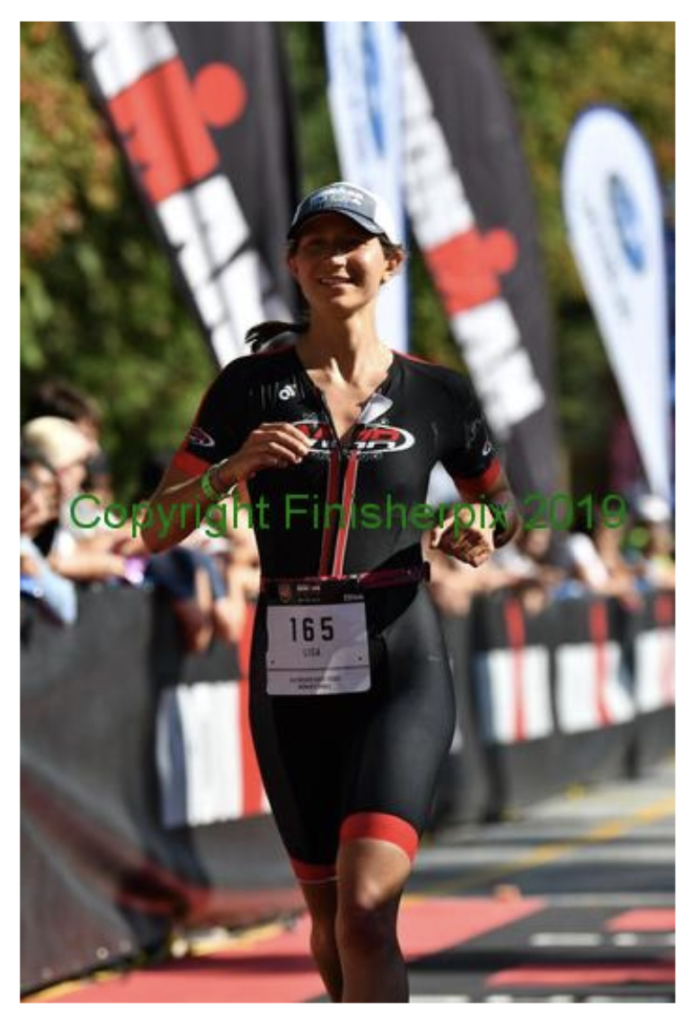
As I rounded the corner towards the finish line, I realized there was yet another out-and-back segment that I had to run; as I accelerated around several 90-degree turns, I felt my diaphragm threatening to give me a stitch and I dug my hand under my ribcage and massaged the deep muscle. It was as if my core was too fatigued to help stabilize my body for sharp turns at this point. I was so excited and relieved to actually be running down the finish chute that I no longer cared that it had taken me over 4 hours to run the marathon; I felt exhausted but so happy to finally stop moving forward. My time was 11:08:48, much faster than my goal time of 12 hours. Alison had somehow managed to sneak into the finish area and gave me a congratulatory hug, asked me how I was feeling and told me that I was 3rd in my age group – I was shocked but so happy! She encouraged me to walk around a bit (even though all I wanted to do was lie down) and I felt like I no longer knew how to put one foot in front of the other.
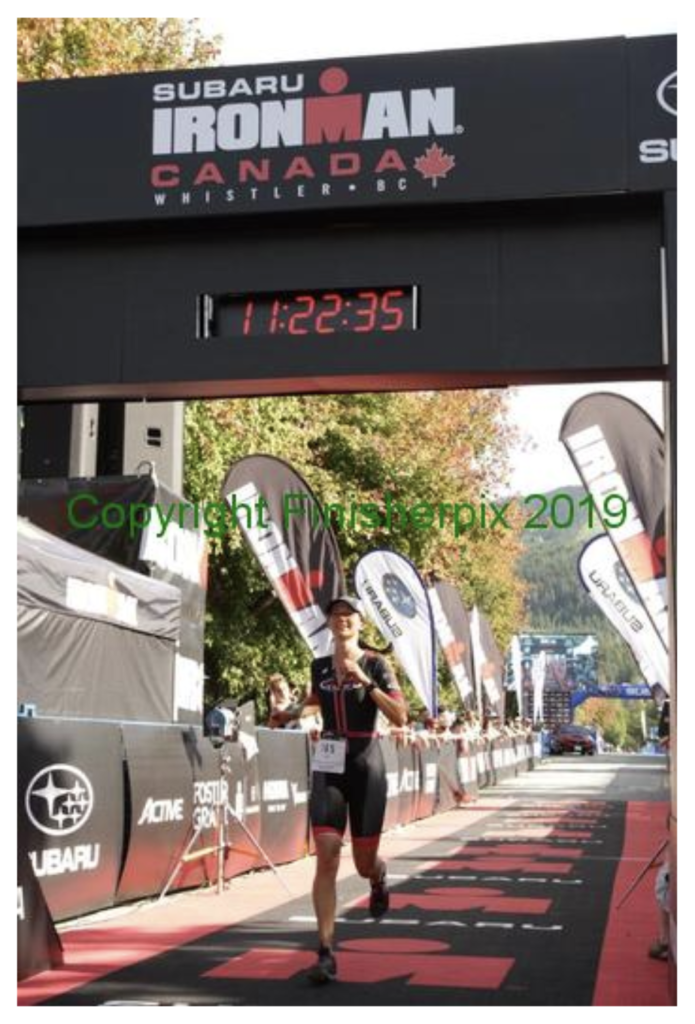
Run Nutrition:
- 2 x First Endurance Canada EFS Liquid Shot (Kona Mocha & Vanilla)
- Water and ice at every aid station
- Coke from 34k onwards (I stopped ingesting EFS Liquid Shots)
Post Race
I took Alison’s advice and walked around the finish area on my wobbly legs. I managed to meet up with a childhood boating friend from Ontario who I hadn’t seen in over 10 years, who had recently moved to Kelowna! After finishing her first 70.3 distance race a few hours earlier, she returned to the finish line to cheer athletes down the finish chute. I chatted with her and her friend for a few minutes, then ventured over to the Village to grab some post-race pizza, fries, pretzels and Coke to prevent myself from feeling nauseous, as I often do when I don’t eat soon enough after exercise. Alison figured that Rod would still be out on the course for at least another hour after me, so I picked up my bike and gear bags from T2, loaded my bike into Rod’s truck, changed out of my disgusting, salt-stained onesie and returned to see Rod sprint across the finish line at 12:28:37.
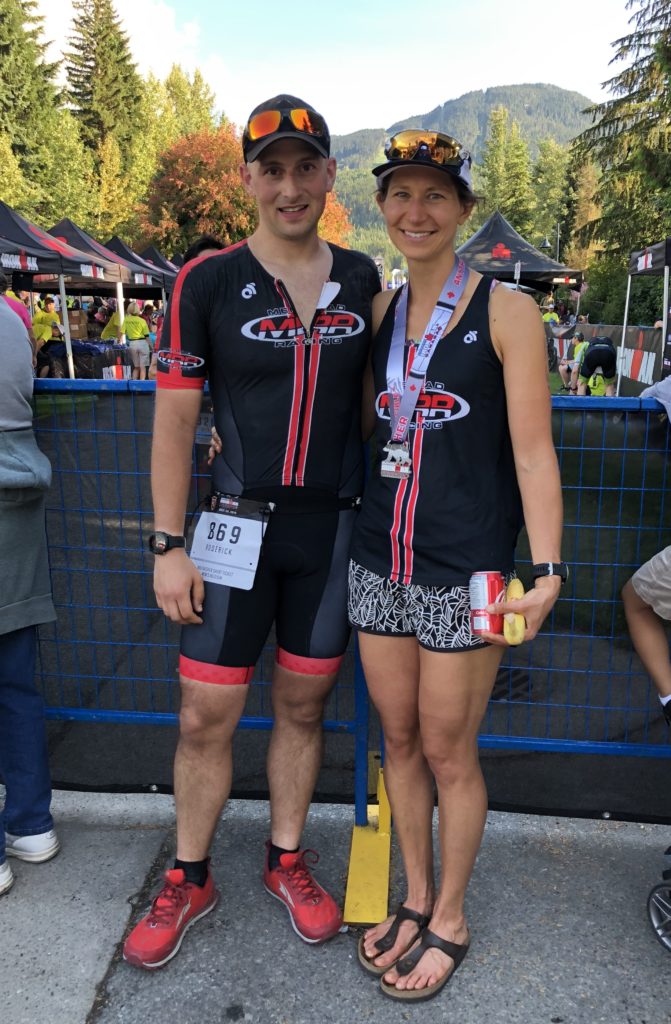
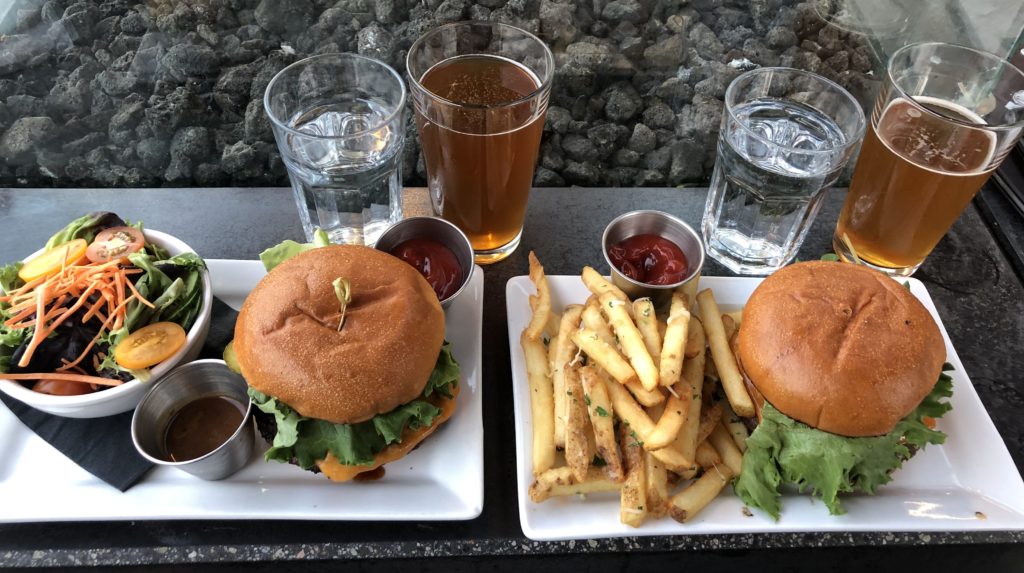
We celebrated with burgers and beer at the Garibaldi Lift Company at the base of Whistler Mountain, and we were joined by Alison, Jason S., Mel and Mike until after 10 pm. On our slow and painful walk back to the truck, Rod and I stopped to cheer a few final finishers down the finish chute and were amazed at the number of spectators and volunteers still cheering. By the time we returned to our Airbnb, it was after 10:30 pm and we were both exhausted. My heart felt like it was pounding out of my chest and my whole body was warm, probably from 11+ hours of physical exertion and a day’s worth of sun exposure. I don’t think I have ever been that exhausted but so relieved that we both successfully completed our first Ironman.
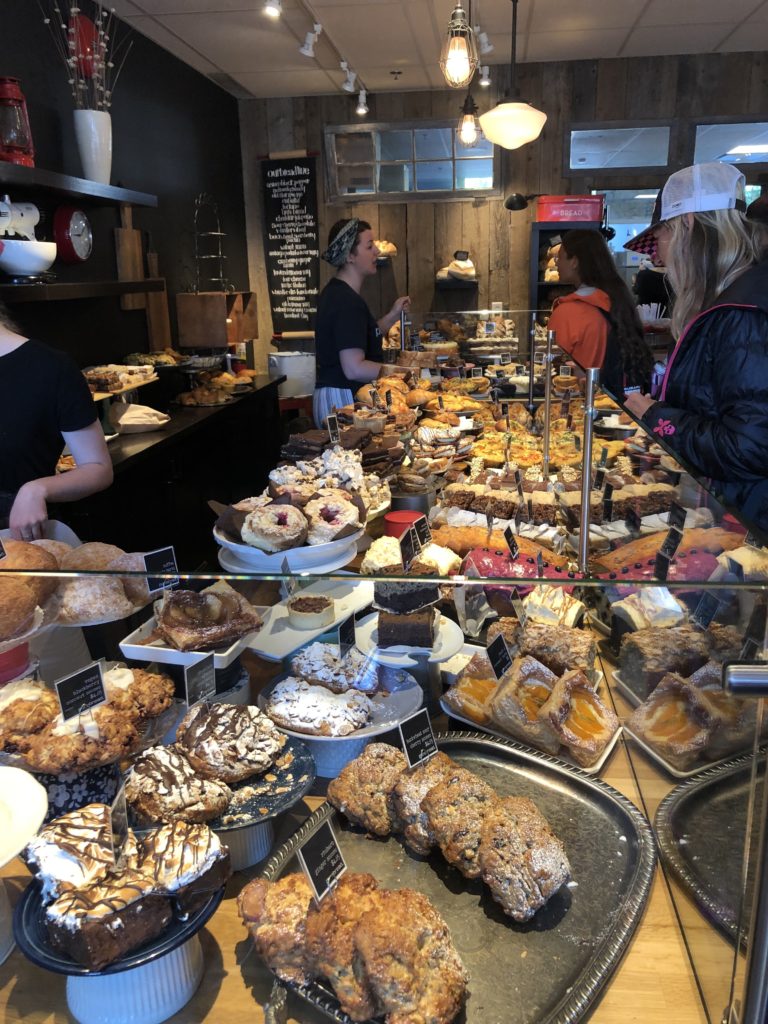
So many delicious baked treats 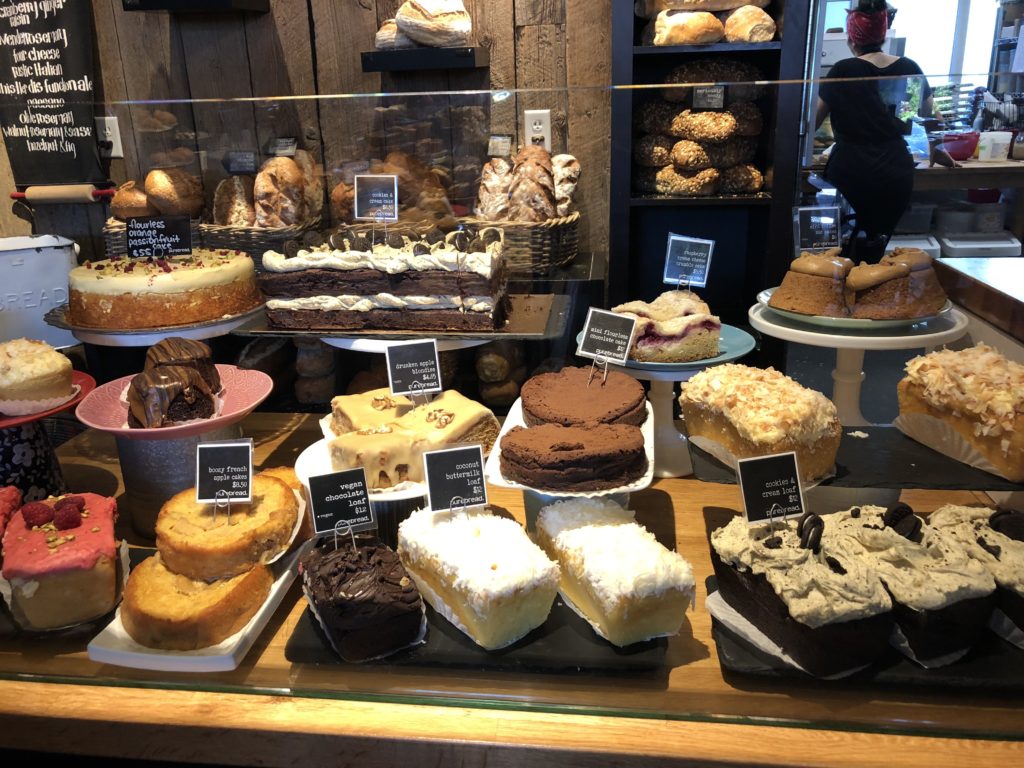
Perfect place to replenish glycogen stores
The next morning, our MelRad squad met at Purebread for delicious baked goods and caffeinated beverages before the awards ceremony. I went up on stage to accept my 3rd place award for women 30 to 34. Rod and I stuck around with 2 of our teammates to see if I could snag a Kona slot at the World Championship Slot Allocation and Rolldown; unfortunately, there was only one spot for my age group and I wasn’t able to get ahold of it.
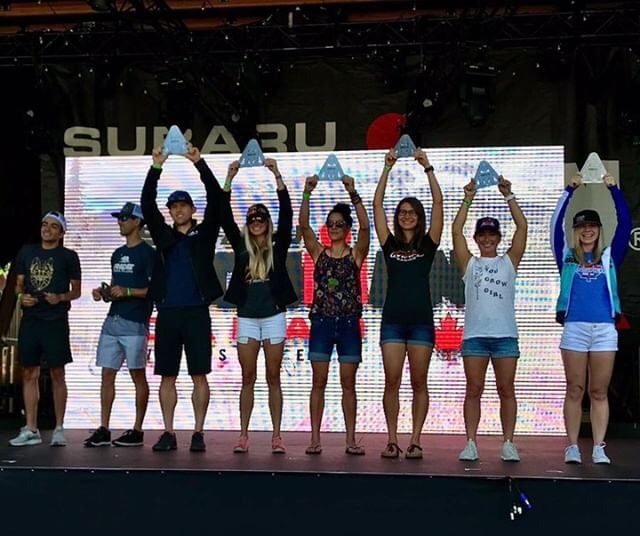
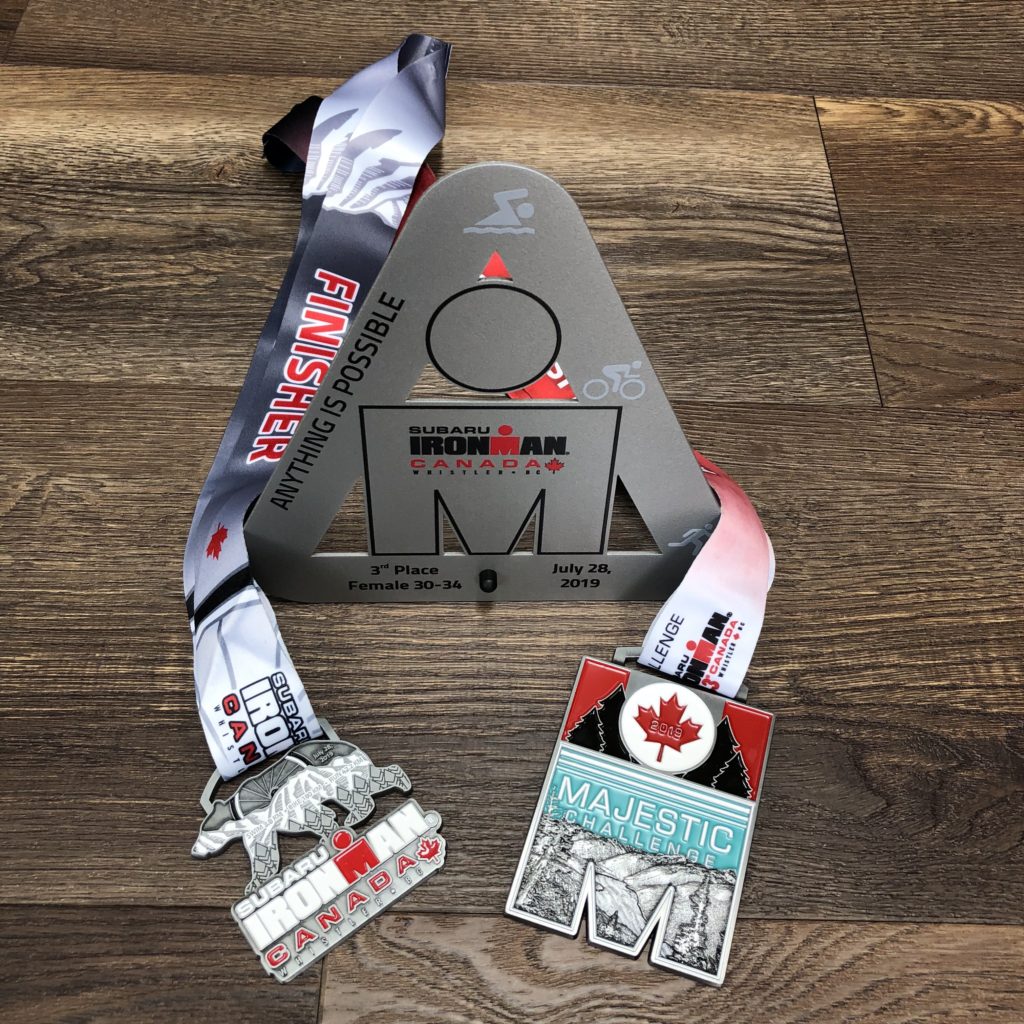
Reflection
I’m really pleased with my first full Ironman performance. In terms of my swim, I’m happy with my time but I know that I could have swam even faster had I sighted more frequently and remained on-course (my Garmin thinks I swam an extra 130m). I want to work on increasing my turnover over the next year. I need to figure out a routine where I can have a last-minute porta potty stop and/or do a warm-up swim so I can start the race with an empty bladder! I’m satisfied with my ride and I realize that I could have saved 2 to 3 minutes if I hadn’t stopped at the Special Needs station. However, I’m not a huge fan of BASE Hydro (I never used it in training) and I really needed to empty my bladder at that perfectly situated porta potty. My legs definitely felt better after riding with a cadence of 80 rpm as opposed to the 90 rpm that I raced with at Victoria 70.3. I know I shouldn’t be too critical of my first marathon, but I should have been able to run a sub 4h marathon and I think my running is the discipline that I need to work on the most in the next year. My left hamstring felt super tired and tight towards the last 8 to 10k, but I was pleasantly surprised to not feel pain in my right lateral knee, as that was really bothering me back in April and May. I think it was smart to stick to the ‘walk the aid station’ plan for the entire run because it helped me break down the distance into smaller, more achievable segments and gave my body a bit of a break.
I am so grateful for the physical and psychological preparation and constant support from my coach, Mel McQuaid. I have learned so much since we started working together in December 2018. Throughout the winter, she essentially taught me how to swim with proper technique, which has been my weakest discipline over the past decade in the sport. I am incredibly thankful for my husband, Rod, who joined me for countless workouts (including our high-volume training trip to Maui), endured my obsessive need to stick exactly to the workouts and tolerated my occasional, hunger-induced post-workout crankiness, regardless of how sleep-deprived he was. Lastly, thank you to my fellow MelRad teammates who answered all my silly logistical questions, cheered for me and high-fived me on the run course and put up with my whining during tough group training sessions. Although triathlon is an individual sport, I truly believe that we can each perform better with the support of a group!
